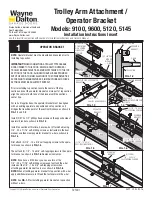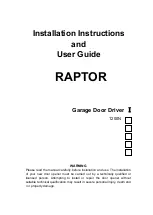
33
CLASS IV - RESTRICTED ACCESS VEHICULAR GATE OPERATOR -
A vehicular gate operator
(or system) intended for use in a guarded industrial location or building such as an airport security
area or other restricted access locations not servicing the general public, in which unauthorized ac-
cess is prevented via supervision by security personnel.
LOCK-
Ceases all operator function except HIGH PRIORITY inputs.
ENTRAPMENT -
The condition when an object is caught or held in a position that increases the risk
of injury.
FORCE STATIC -
Constant load threshold for sensitivity setting.
FORCE DYNAMIC -
Impact sensitivity setting.
GATE -
A moving barrier such as a swinging, sliding, raising, lowering, or the like, barrier, that is a
stand-alone passage barrier or is that portion of a wall or fence system that controls entrance and/or
egress by persons or vehicles and completes the perimeter of a defined area.
(STEP H) HIGH PRIORITY -
Step by step control.
INHERENT ENTRAPMENT SENSOR SYSTEM -
An automatic sensor system which senses entrap-
ment of a solid object and is incorporated as a permanent and integral part of the operator.
STEP BY STEP -
Command that opens-stops-closes-stops the gate with each press of the button.
SYSTEM -
In the context of these requirements, a system refers to a group of interacting devices in-
tended to perform a common function.
UNLOCK -
Resumes normal operation after a blocked condition.
WIRED CONTROL -
A control implemented in a form of fixed physical interconnections between the
control, the associated devices, and an operator to perform predetermined functions in response to
input signals.
WIRELESS CONTROL -
A control implemented in means other than fixed physical interconnections
(such as radio waves or infrared beams) between the control, the associated devices, and an opera-
tor to perform predetermined functions in response to input signals.
TOGGLE AND LATCH
- When radio channel set to TOGGLE and LATCH, first activation will open
and hold gate open (LATCHed). Second activation will unlatch gate and allow it to autoclose or be
closed by some other method.
12 - GLOSSARY (Continued)
The automatic vehicular gate system must be designed to allow access to emergency vehicles
under different operating conditions.
During normal powered operation, emergency vehicles access the gate by use of the emergency
vehicle access device installed on your gate system. The type of device that is used in your com-
munity is dependent on your city codes. These devices may include (but are not limited to) Fire
Department lock boxes, Click-2-Enter radio receivers, strobe light sensors, siren sensors, etc.
If applicable, this operator is equipped with a manual release system that will allow the gate to be
pushed open in the event of a power outage or equipment failure.
NOTE: Never attempt to manually push open any gate with an operator attached to it until you
have verified that power to the operator has been shut-off.
The automatic vehicular gate system must be designed to allow access to emergency vehicles
under different operating conditions.
In the event of a power failure, the emergency vehicle access device may not be functional be-
cause the gate operator is un-powered. NOTE: DC powered back-up systems are optional and
your gate system may or may not be equipped with one. Check with your installer to determine if
your gate system is equipped with a back-up power system.
13 - EMERGENCY VEHICLE ACCESS





































